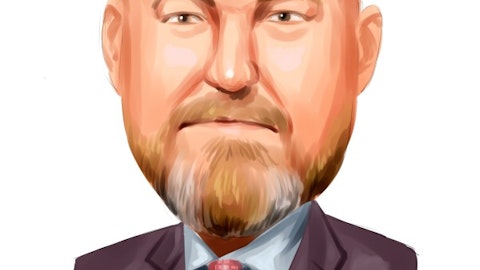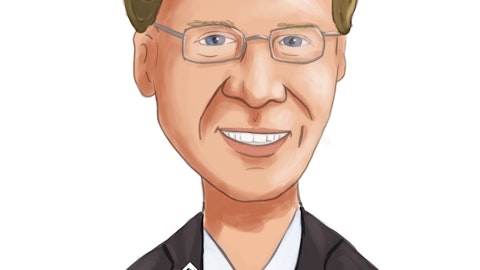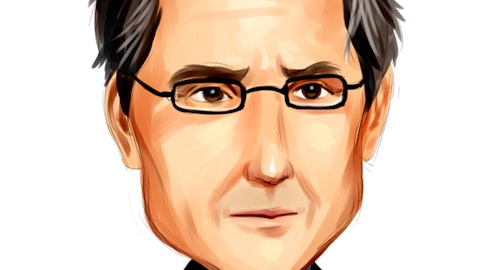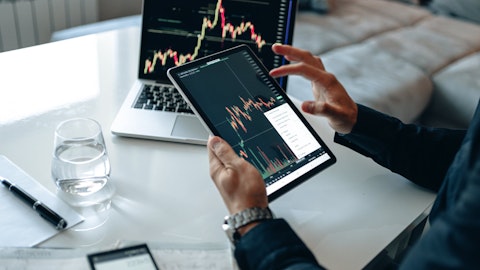Scott Henry: Okay. Great. And I know you had that orphan drug compound. Any updates on that on where we stand anything we should be thinking about as far as catalysts there?
Dan Peisert: Yeah. We had — I’ve been wrong for probably 18 months about predicting when they were going to be able to file that. So I made a comment last time that we really wouldn’t say anything until the FDA has accepted their filing just so I don’t keep getting myself out over my skis on predicting this one. But everything is — as far as I’m aware, everything is progressing just slower than I would like. And because we can’t control it we’re just going to not comment on predictions.
Scott Henry: Okay. Fair enough. And then final just bookkeeping questions. One, what should we think about for a tax rate now that it will be a traditional tax rate in 2023? And with wiping out the convert and all that, what’s probably a good shares outstanding number when we’re at a steady state here?
Paul Schwichtenberg: Scott, this is Paul. Now the tax rate is going to be low double-digits probably between 10% and 12%. And the outstanding share number I mean we would refer you to our K, but basically we’re looking at for the — basically we were at 48 million shares, when you add in the full impact of the $171 million that gets you into the mid-60s.
Dan Peisert: Yeah. I think the amount that we had for the fourth quarter is going to be a good proxy Scott the exchange that we did it just — it reduced dilution by right. What was it just around 400,000 shares?
Paul Schwichtenberg: Right.
Dan Peisert: So the fourth quarter number is a good proxy.
Scott Henry: Okay. And just one follow-up there on the tax rate. I mean, given that you book the tax asset now into the income statement why wouldn’t you be up around 22% rate or what you traditionally expect?
Paul Schwichtenberg: We’re still going to be getting the benefit of some NOLs that we have on the balance sheet or that we have — we still have out there able to use. Our gross on NOLs on the federal side are about $250 million.
Scott Henry: Okay. So you’re still — okay. So you’re talking from a cash tax rate or you now.
Paul Schwichtenberg: Right. That we report.
Scott Henry: Okay. Thank you for taking the questions.
Dan Peisert: Thanks, Scott.
Operator: Thank you. The next question is from the line of Hamed Khorsand with BWS Financial. You may proceed.
Dan Peisert: Hey, Hamed.
Hamed Khorsand: Hi. So the first question I had was on this ASEG guideline change, given that it’s pretty much the same population of doctors using INDOCIN wanted to translate into being a fast kind of transition, or what would the slowdown be?
Dan Peisert: We don’t have a great analog. When they first put out the guidelines five years ago to include indomethacin for high risk is it already being used for that since the New England — the first publication was in the New England Journal in I think late 2012 or early -2013. So the trend was continuing it accelerated a little bit in 2017. And we know physicians are well aware of this. So we’re — the potential certainly does exist for this to accelerate from here, until we can finalize our strategies for education and awareness that are going to be compliant. We’re going to be cautious on, I guess, sticking our necks out to predict what the growth opportunity could be, or what the shape of that looks like? There’s no doubt, it is a tremendous opportunity for us.
Hamed Khorsand: And on the inventory front, do you feel comfortable with what you can manufacture and how much is in the channel for if there is any kind of growth out there this year?
Dan Peisert: That is a tremendous question, and what we’ve all been thinking about since we saw these guidelines last week. We have ample inventory today. You can see that on the balance sheet. The vast majority of that inventory is INDOCIN. And we’re — we’ve been talking with our supplier and contemplating what we could do to accelerate some of the POs that we have outstanding already.
Hamed Khorsand: Okay. And the last question is just on pricing. Do you feel comfortable with where pricing is for instance? Do you think there’s room to increase it if you still — you start having shortages of supply?
Dan Peisert: Good question. I’m not planning to have shortages of supply. I’m going to do everything I can to make sure that we have adequate supply. Right now we are comfortable with where the pricing is or the product.
Hamed Khorsand: Okay. Thank you.
Operator: The next question is from the line of Mitra Ramgopal with Sidoti. You may proceed.




